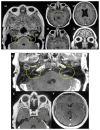Neglected and (re-)emergent infections of the CNS i n low-/middle-income countries
- PMID: 35146359
- PMCID: PMC8805465
- DOI: 10.53854/liim-2904-3
Neglected and (re-)emergent infections of the CNS i n low-/middle-income countries
Abstract
Low- and middle-income countries (LMIC) have suffered from long-term health system deficiencies, worsened by poor living conditions, lack of sanitation, a restricted access to health facilities and running water, overcrowding, and overpopulation. These factors favor human displacement and deepen marginalization; consequently, their population endures a high burden of infectious diseases. In this context, the current epidemiological landscape and its impact on health and economic development are not promissory, despite the commitment by the international community to eradicate neglected tropical infections - especially tuberculosis and malaria, by 2030. Neglected and (re)-emerging infectious diseases affecting the central nervous system (CNS) are a major public health concern in these countries, as they cause a great morbidity and mortality; furthermore, survivors often suffer from severe neurological disabilities. Herein, we present a retrospective review focused on some neglected and (re)-emerging infectious diseases, including neurocysticercosis, malaria, rabies, West Nile virus encephalitis, tuberculosis, neuroborreliosis, and SARS-CoV-2 in LMIC. A retrospective review of studies on selected neglected and (re)-emerging infectious diseases in LMIC was performed, including reports by the World Health Organization (WHO) published within the last five years. Data on infection by SARS-CoV-2 were provided by the John Hopkins University Coronavirus Resource Center. CNS neglected and (re)-emerging infectious diseases remain as important causes of disease in LMIC. An alarming increase in the prevalence of malaria, tuberculosis, and cysticercosis is observed in the region, compounded by the recent COVID-19 pandemic. The WHO is currently supporting programs/efforts to cope with these diseases. Herein, we highlight the epidemiological burden of some CNS infections in LMIC, and their clinical and neuroimaging features, to facilitate an accurate diagnosis, considering that most of these diseases will not be eradicated in the short term; instead, their incidence will likely increase along with poverty, inequality, and related socioeconomic problems.
Keywords: Neglected; central nervous system; emergent; infections; low/middle income countries.
Copyright © 2016 - 2021 InfezMed.
Conflict of interest statement
Competing interests statement The authors declare that no conflict of interest exists.
Figures








Similar articles
-
Challenges of COVID-19 in children in low- and middle-income countries.Paediatr Respir Rev. 2020 Sep;35:70-74. doi: 10.1016/j.prrv.2020.06.016. Epub 2020 Jun 25. Paediatr Respir Rev. 2020. PMID: 32654854 Free PMC article. Review.
-
Poverty-related and neglected diseases - an economic and epidemiological analysis of poverty relatedness and neglect in research and development.Glob Health Action. 2015 Jan 22;8:25818. doi: 10.3402/gha.v8.25818. eCollection 2015. Glob Health Action. 2015. PMID: 25623607 Free PMC article.
-
The impact of COVID-19 on communicable and non-communicable diseases in Africa: a narrative review.Infez Med. 2022 Mar 1;30(1):30-40. doi: 10.53854/liim-3001-4. eCollection 2022. Infez Med. 2022. PMID: 35350264 Free PMC article. Review.
-
Higher coronavirus disease-19 mortality linked to comorbidities: A comparison between low-middle income and high-income countries.J Educ Health Promot. 2021 Oct 29;10:377. doi: 10.4103/jehp.jehp_142_21. eCollection 2021. J Educ Health Promot. 2021. PMID: 34912913 Free PMC article.
-
[Development of antituberculous drugs: current status and future prospects].Kekkaku. 2006 Dec;81(12):753-74. Kekkaku. 2006. PMID: 17240921 Review. Japanese.
Cited by
-
Interventions to support the mental health of family carers of children with brain injury in low and middle income countries: a scoping review.Front Rehabil Sci. 2024 Aug 29;5:1405674. doi: 10.3389/fresc.2024.1405674. eCollection 2024. Front Rehabil Sci. 2024. PMID: 39268477 Free PMC article.
-
Concordance between a New Rapid Point-Of-Care Assay and Standard ELISA in the Detection of Cysticercosis Antigens in Urine.Am J Trop Med Hyg. 2024 Aug 13;111(4):823-825. doi: 10.4269/ajtmh.24-0171. Print 2024 Oct 2. Am J Trop Med Hyg. 2024. PMID: 39137750
-
Effective degradation of various bacterial toxins using ozone ultrafine bubble water.PLoS One. 2024 Jul 10;19(7):e0306998. doi: 10.1371/journal.pone.0306998. eCollection 2024. PLoS One. 2024. PMID: 38985791 Free PMC article.
-
From laboratory to clinical practice: an update of the immunological and molecular tools for neurocysticercosis diagnosis.Front Parasitol. 2024 Jul 1;3:1394089. doi: 10.3389/fpara.2024.1394089. eCollection 2024. Front Parasitol. 2024. PMID: 39817165 Free PMC article. Review.
-
Concordance between two monoclonal antibody-based antigen detection enzyme-linked immunosorbent assays for measuring cysticercal antigen levels in sera from pigs experimentally infected with Taenia solium and Taenia hydatigena.Parasit Vectors. 2024 Apr 2;17(1):172. doi: 10.1186/s13071-024-06197-6. Parasit Vectors. 2024. PMID: 38566124 Free PMC article.
References
-
- GBD 2016 DALY and HALE collaborators global, regional, and national disability-adjusted life-years (DALYs) for 333 diseases and injuries and healthy life expectancy (HALE) for 195 countries and territories, 1990–2012. A systematic analysis for the Global Burden of Disease Study 2016. Lancet. 2017;390(10100):1260–344. - PMC - PubMed
-
- World Population Ageing 2020 Highlights. [[accessed November 1, 2021].]. https://www.un.org/development/desa/pd/sites/www.un.org/development.desa... .
-
- World Population 2019. [[accessed November 1, 2021].]. At https://population.un.org/wpp/Publications/Files/WPP2019-wallchart.pdf.
-
- Kimura-Hayama ET, Higuera JA, Corona-Cedillo R, et al. Neurocysticercosis:radiologic-pathologic correlation. Radiographics. 2010;30(6):1705–19. - PubMed
Publication types
LinkOut - more resources
Full Text Sources
Miscellaneous
